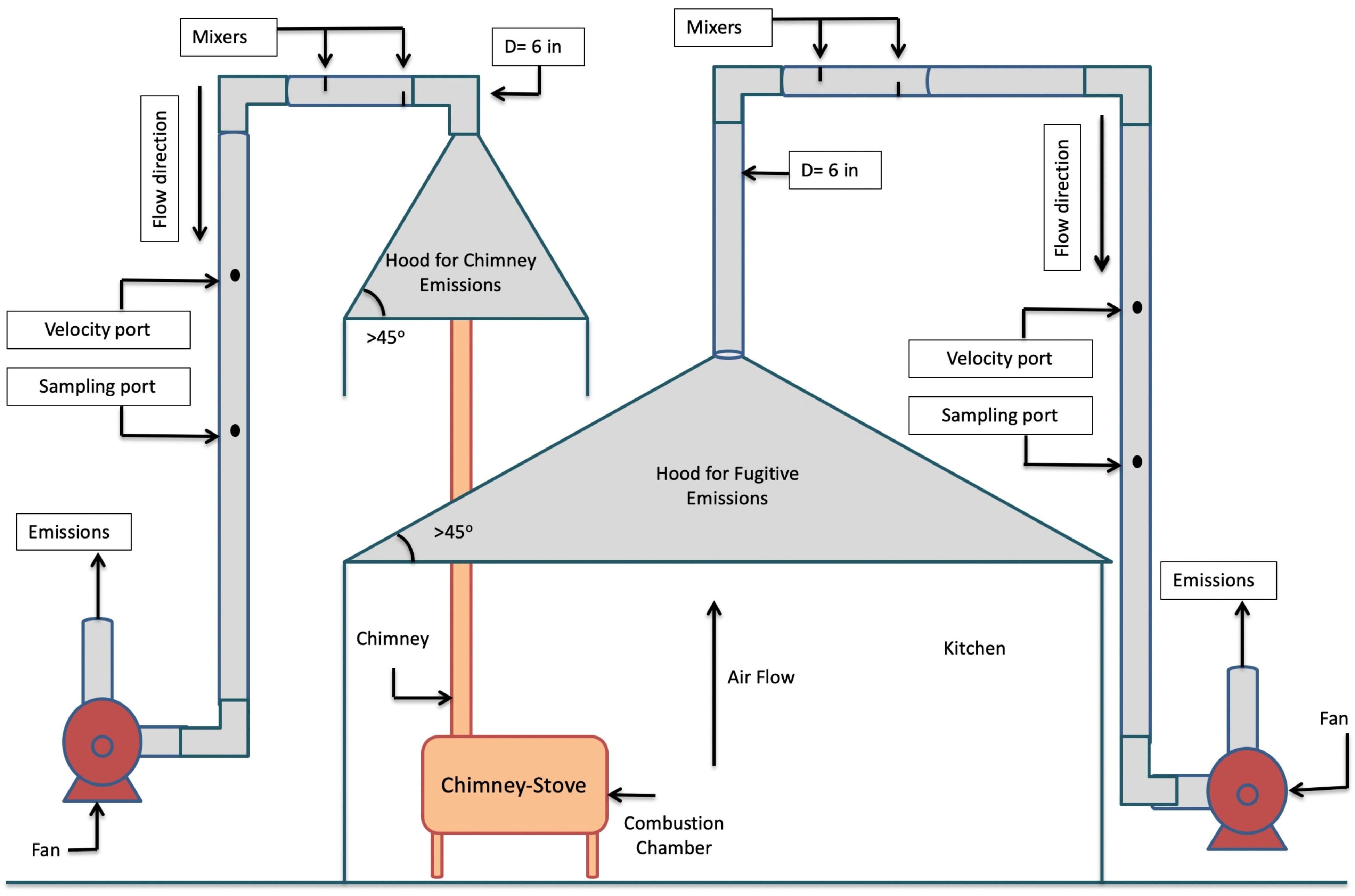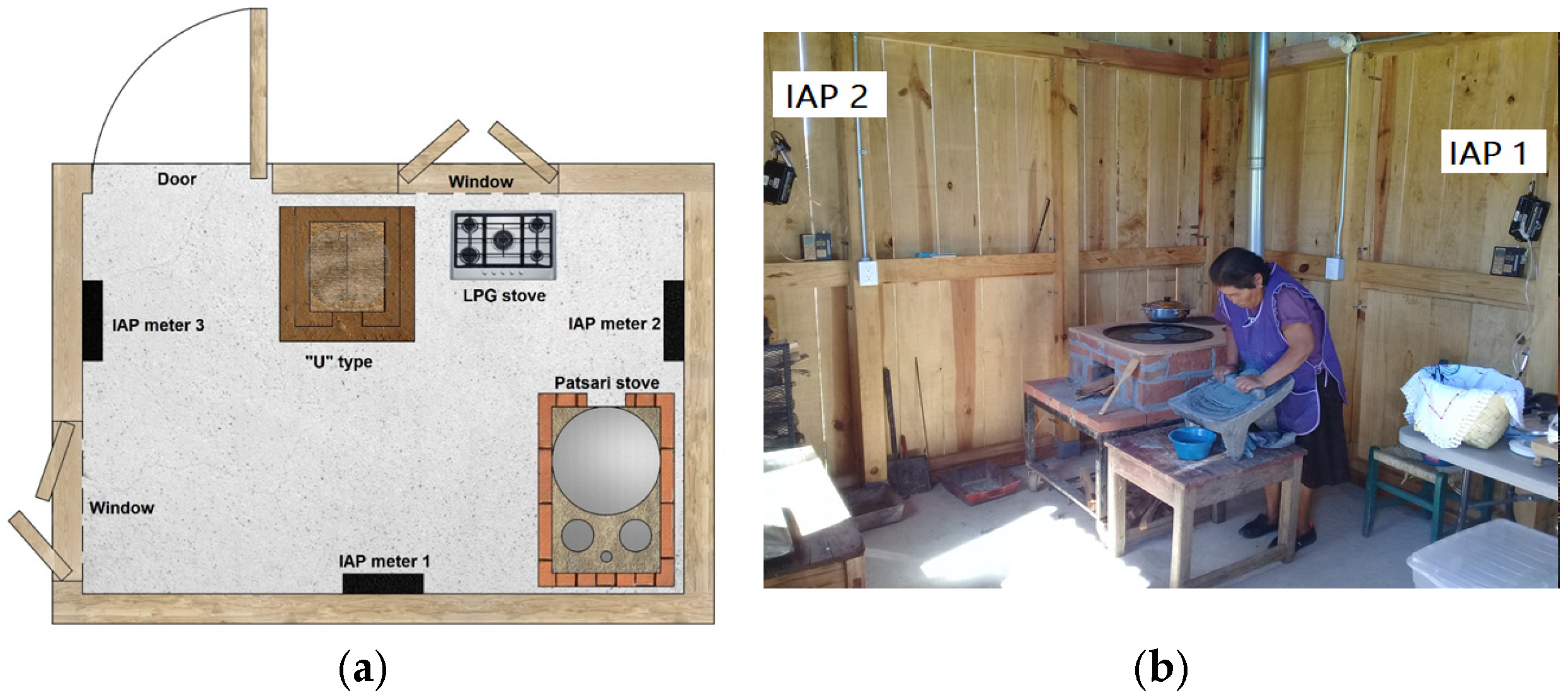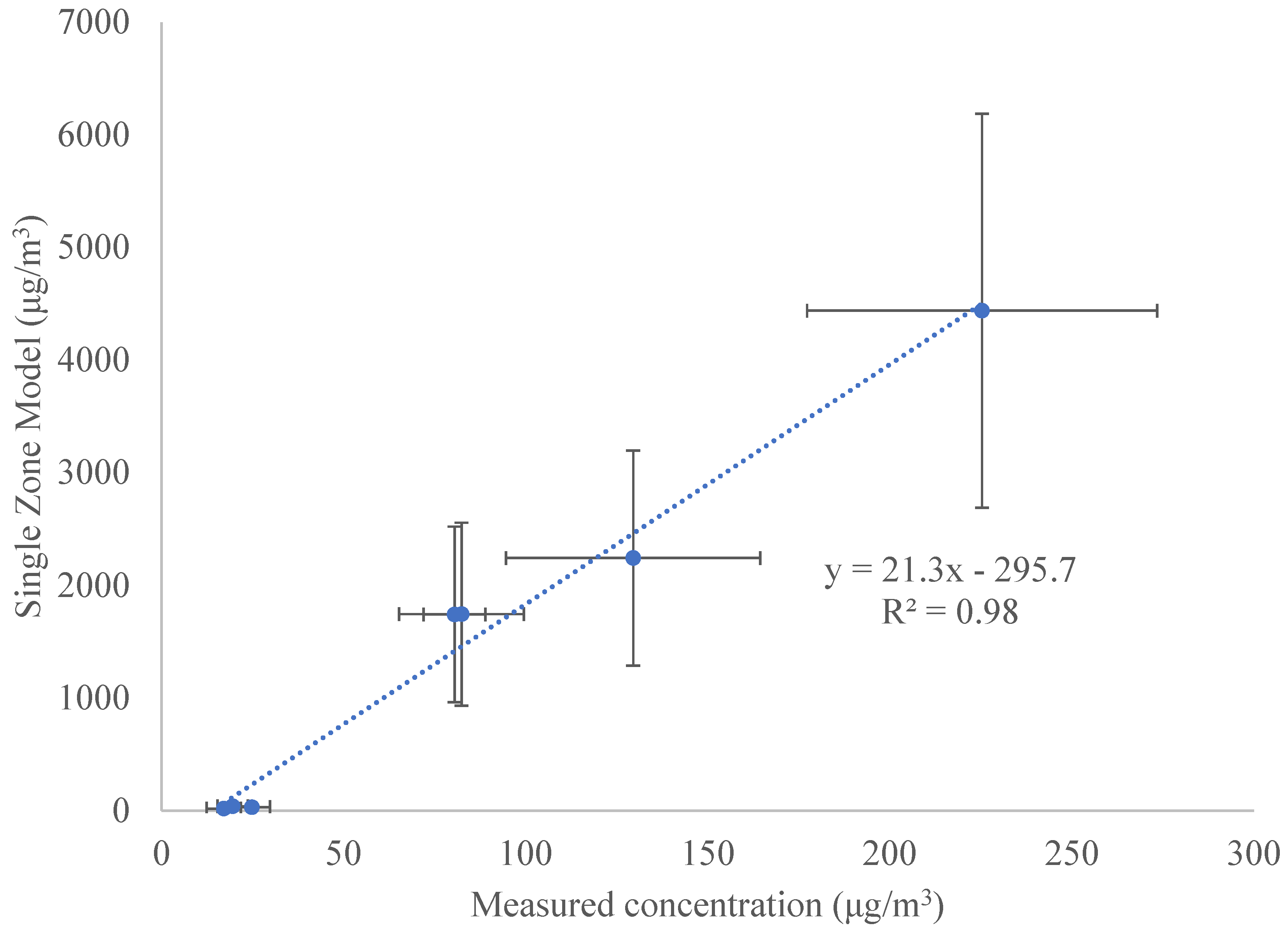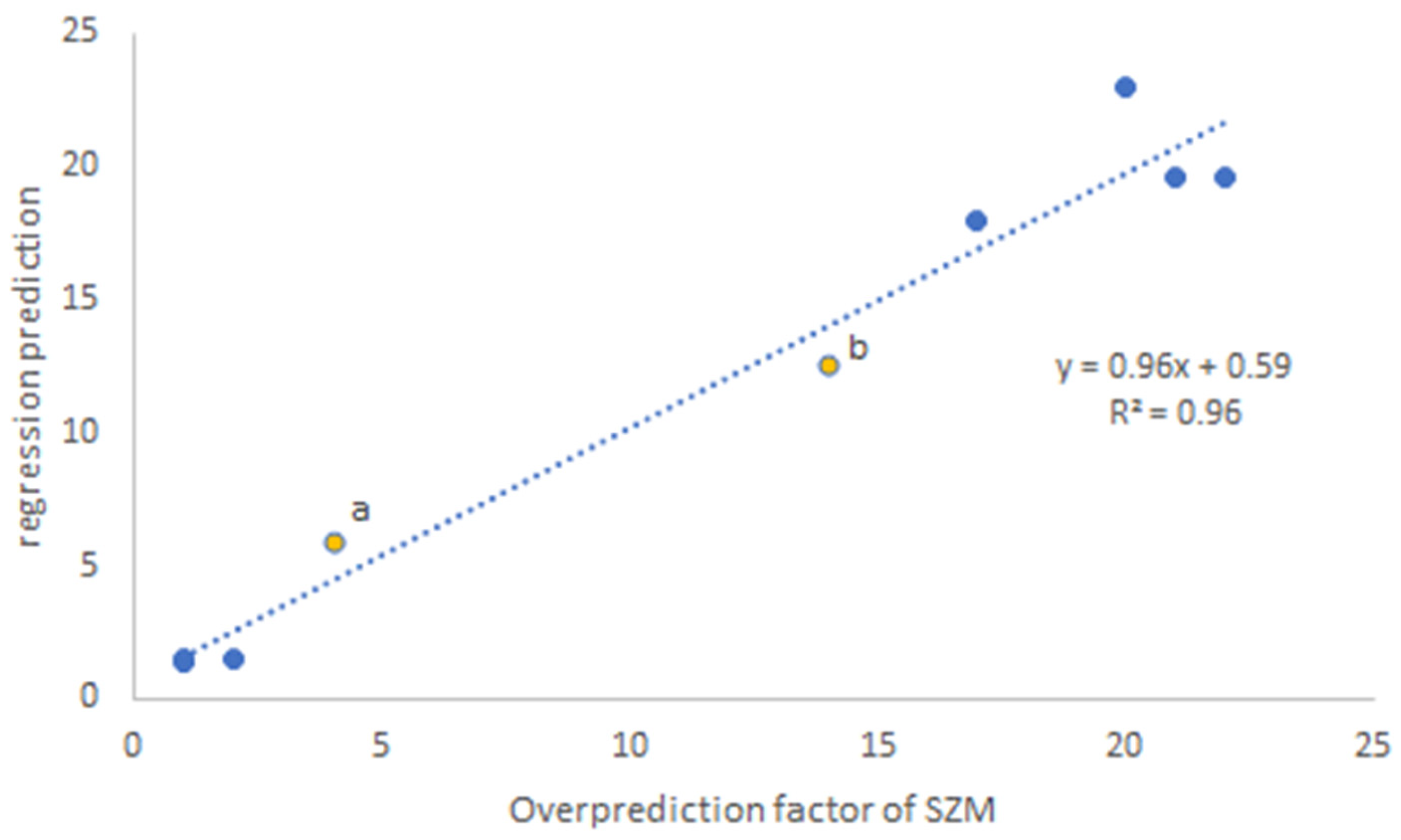Regional Emission Performance Benchmarks for Cookstove Stacking in the Purepecha Region, Mexico
Abstract
1. Introduction
2. Materials and Methods
2.1. Devices, Fuels, and Cooking Tasks
2.2. Test Kitchen
2.3. Fugitive and Chimney Emissions Measurements
2.4. Indoor Air Pollution Measurements
2.5. Single Zone Model
3. Results
3.1. Fugitive and Chimney Emissions
3.2. Indoor Air Pollution
4. Discussion
5. Conclusions
Supplementary Materials
Author Contributions
Funding
Institutional Review Board Statement
Data Availability Statement
Acknowledgments
Conflicts of Interest
References
- Stoner, O.; Lewis, J.; Martínez, I.L.; Gumy, S.; Economou, T.; Adair-Rohani, H. Household cooking fuel estimates at global and country level for 1990 to 2030. Nat. Commun. 2021, 12, 5793. [Google Scholar] [CrossRef]
- Puzzolo, E.; Fleeman, N.; Lorenzetti, F.; Rubinstein, F.; Li, Y.; Xing, R.; Shen, G.; Nix, E.; Maden, M.; Bresnahan, R.; et al. Estimated health effects from domestic use of gaseous fuels for cooking and heating in high-income, middle-income, and low-income countries: A systematic review and meta-analyses. Lancet Respir. Med. 2024, 12, 281–293. [Google Scholar] [CrossRef] [PubMed]
- Jetter, J.; Zhao, Y.; Smith, K.R.; Khan, B.; Yelverton, T.; DeCarlo, P.; Hays, M.D. Pollutant emissions and energy efficiency under controlled conditions for household biomass cookstoves and implications for metrics useful in setting international test standards. Environ. Sci. Technol. 2012, 46, 10827–10834. [Google Scholar] [CrossRef] [PubMed]
- World Health Organization. WHO Guidelines for Indoor Air Quality: Household Fuel Combustion; World Health Organization: Geneva, Switzerland, 2014. [Google Scholar]
- Johnson, M.; Lam, N.; Brant, S.; Gray, C.; Pennise, D. Modeling indoor air pollution from cookstove emissions in developing countries using a Monte Carlo single-box model. Atmos. Environ. 2011, 45, 3237–3243. [Google Scholar] [CrossRef]
- Johnson, M.; Edwards, R.; Berrueta, V.; Masera, O. New approaches to performance testing of improved cookstoves. Environ. Sci. Technol. 2010, 44, 368–374. [Google Scholar] [CrossRef]
- Roden, C.A.; Bond, T.C.; Conway, S.; Pinel, A.B.O.; MacCarty, N.; Still, D. Laboratory and field investigations of particulate and carbon monoxide emissions from traditional and improved cookstoves. Atmos. Environ. 2009, 43, 1170–1181. [Google Scholar] [CrossRef]
- Johnson, M.A.; Garland, C.R.; Jagoe, K.; Edwards, R.; Ndemere, J.; Weyant, C.; Patel, A.; Kithinji, J.; Wasirwa, E.; Nguyen, T. In-home emissions performance of cookstoves in Asia and Africa. Atmosphere 2019, 10, 290. [Google Scholar] [CrossRef]
- Weltman, R.M.; Edwards, R.D.; Fleming, L.T.; Yadav, A.; Weyant, C.L.; Rooney, B.; Seinfeld, J.H.; Arora, N.K.; Bond, T.C.; Nizkorodov, S.A. Emissions measurements from household solid fuel use in Haryana, India: Implications for climate and health co-benefits. Environ. Sci. Technol. 2021, 55, 3201–3209. [Google Scholar] [CrossRef]
- Eilenberg, S.R.; Bilsback, K.R.; Johnson, M.; Kodros, J.K.; Lipsky, E.M.; Naluwagga, A.; Fedak, K.M.; Benka-Coker, M.; Reynolds, B.; Peel, J. Field measurements of solid-fuel cookstove emissions from uncontrolled cooking in China, Honduras, Uganda, and India. Atmos. Environ. 2018, 190, 116–125. [Google Scholar] [CrossRef]
- Shankar, A.V.; Quinn, A.K.; Dickinson, K.L.; Williams, K.N.; Masera, O.; Charron, D.; Jack, D.; Hyman, J.; Pillarisetti, A.; Bailis, R. Everybody stacks: Lessons from household energy case studies to inform design principles for clean energy transitions. Energy Policy 2020, 141, 111468. [Google Scholar] [CrossRef]
- Catalán-Vázquez, M.; Fernández-Plata, R.; Martínez-Briseño, D.; Pelcastre-Villafuerte, B.; Riojas-Rodríguez, H.; Suárez-González, L.; Pérez-Padilla, R.; Schilmann, A. Factors that enable or limit the sustained use of improved firewood cookstoves: Qualitative findings eight years after an intervention in rural Mexico. PLoS ONE 2018, 13, e0193238. [Google Scholar] [CrossRef] [PubMed]
- Traynor, G.; Apte, M.; Dillworth, J.; Hollowell, C.; Sterling, E. The effects of ventilation on residential air pollution due to emissions from a gas-fired range. Environ. Int. 1982, 8, 447–452. [Google Scholar] [CrossRef]
- Ruiz-García, V.M.; Edwards, R.D.; Ghasemian, M.; Berrueta, V.M.; Princevac, M.; Vázquez, J.C.; Johnson, M.; Masera, O.R. Fugitive emissions and health implications of plancha-type stoves. Environ. Sci. Technol. 2018, 52, 10848–10855. [Google Scholar] [CrossRef] [PubMed]
- Grabow, K.; Still, D.; Bentson, S. Test Kitchen studies of indoor air pollution from biomass cookstoves. Energy Sustain. Dev. 2013, 17, 458–462. [Google Scholar] [CrossRef]
- Champion, W.M.; Hays, M.D.; Williams, C.; Virtaranta, L.; Barnes, M.; Preston, W.; Jetter, J.J. Cookstove emissions and performance evaluation using a new ISO protocol and comparison of results with previous test protocols. Environ. Sci. Technol. 2021, 55, 15333–15342. [Google Scholar] [CrossRef]
- Johnson, M.; Edwards, R.; Frenk, C.A.; Masera, O. In-field greenhouse gas emissions from cookstoves in rural Mexican households. Atmos. Environ. 2008, 42, 1206–1222. [Google Scholar] [CrossRef]
- Johnson, M.; Piedrahita, R.; Pillarisetti, A.; Shupler, M.; Menya, D.; Rossanese, M.; Delapeña, S.; Penumetcha, N.; Chartier, R.; Puzzolo, E. Modeling approaches and performance for estimating personal exposure to household air pollution: A case study in Kenya. Indoor Air 2021, 31, 1441–1457. [Google Scholar] [CrossRef]
- Piedrahita, R.; Johnson, M.; Bilsback, K.R.; L’Orange, C.; Kodros, J.K.; Eilenberg, S.R.; Naluwagga, A.; Shan, M.; Sambandam, S.; Clark, M. Comparing regional stove-usage patterns and using those patterns to model indoor air quality impacts. Indoor Air 2020, 30, 521–533. [Google Scholar] [CrossRef]
- MacCarty, N.; Bentson, S.; Cushman, K.; Au, J.; Li, C.; Murugan, G.; Still, D. Stratification of particulate matter in a kitchen: A comparison of empirical to predicted concentrations and implications for cookstove emissions targets. Energy Sustain. Dev. 2020, 54, 14–24. [Google Scholar] [CrossRef]
- Mundt, E. Convection Flows in Rooms with Temperature Gradients-Theory and Measurements; DANVAK: Lyngby, Denmark, 1992. [Google Scholar]
- Georges, L.; Thalfeldt, M.; Skreiberg, Ø.; Fornari, W. Validation of a transient zonal model to predict the detailed indoor thermal environment: Case of electric radiators and wood stoves. Build. Environ. 2019, 149, 169–181. [Google Scholar] [CrossRef]
- Kosonen, R.; Koskela, H.; Saarinen, P. Thermal plumes of kitchen appliances: Idle mode. Energy Build. 2006, 38, 1130–1139. [Google Scholar] [CrossRef]
- Lai, A.C.; Chen, F. Modeling of cooking-emitted particle dispersion and deposition in a residential flat: A real room application. Build. Environ. 2007, 42, 3253–3260. [Google Scholar] [CrossRef]
- Lai, A.; Ho, Y. Spatial concentration variation of cooking-emitted particles in a residential kitchen. Build. Environ. 2008, 43, 871–876. [Google Scholar] [CrossRef]
- Shen, X.; Wang, P.; Zhang, X.; Cao, X.; Shi, Y.; Li, X.; Yao, X.; Yao, Z. Real-time measurements of black carbon and other pollutant emissions from residential biofuel stoves in rural China. Sci. Total Environ. 2020, 727, 138649. [Google Scholar] [CrossRef]
- Samoli, E.; Touloumi, G.; Schwartz, J.; Anderson, H.R.; Schindler, C.; Forsberg, B.; Vigotti, M.A.; Vonk, J.; Košnik, M.; Skorkovsky, J. Short-term effects of carbon monoxide on mortality: An analysis within the APHEA project. Environ. Health Perspect. 2007, 115, 1578–1583. [Google Scholar] [CrossRef] [PubMed]
- Dix-Cooper, L.; Eskenazi, B.; Romero, C.; Balmes, J.; Smith, K.R. Neurodevelopmental performance among school age children in rural Guatemala is associated with prenatal and postnatal exposure to carbon monoxide, a marker for exposure to woodsmoke. Neurotoxicology 2012, 33, 246–254. [Google Scholar] [CrossRef] [PubMed]




| Cooking Task | Stacking Option | |||
|---|---|---|---|---|
| Patsari-“U” Type | Patsari-LPG | LPG-“U” Type | Patsari-LPG-“U” Type | |
| 1. Tortillas | Patsari | Patsari | “U” type | Patsari |
| 2. Fried rice | Patsari | Patsari | “U” type | Patsari |
| 3. Boil beans | “U” type | Patsari | “U” type | “U” type |
| 4. Boil water | Patsari | LPG | LPG | LPG |
| 5. Reheating (tortillas and meals) | Patsari | LPG | LPG | LPG |
| 6. Fried food (eggs and beans) | Patsari | LPG | LPG | LPG |
| 7. Nixtamal and heating bath water | Patsari | Patsari | “U” type | Patsari |
| Stacking Type | Chimney Emissions Rate | Fugitive Emissions Rate | Percent of Overall | |||||
|---|---|---|---|---|---|---|---|---|
| g CO2/min | mg CO/min | mg PM2.5/min | g CO2/min | mg CO/min | mg PM2.5/min | CO (%) | PM2.5 (%) | |
| Patsari | 54 ± 1.6 | 1.6 ± 0.2 | 61.3 ± 14 | 0.5 ± 0.1 | 18 ± 9 | 1.9 ± 0.3 | 1.1 ± 0.5 | 3.1 ± 1 |
| “U” type | 58 ± 4.9 | 4.9 ± 2.1 | 395.5 ± 180.7 | 58.1 ± 20.8 | 4873 ± 2145 | 395.5 ± 180.7 | ||
| Patsari | 47 ± 0.6 | 0.6 ± 0.2 | 68.2 ± 33.5 | 0.5 ± 0.1 | 10 ± 7 | 1.8 ± 0.1 | 1.5 ± 0.5 | 2.8 ± 0.9 |
| LPG | 9 ± 0.02 | 0.02 ± 0 | 0.1 ± 0.1 | 9 ± 2.5 | 25 ± 8 | 0.1 ± 0.1 | ||
| “U” type | 66 ± 5.2 | 5.2 ± 1.4 | 361.2 ± 31.9 | 66 ± 6.6 | 5195 ± 1434 | 361.2 ± 31.9 | ||
| LPG | 9 ± 0.02 | 0.02 ± 0 | 0.1 ± 0.1 | 9 ± 2.5 | 25 ± 8 | 0.1 ± 0.1 | ||
| Patsari | 37 ± 1.1 | 1.1 ± 0.2 | 50.5 ± 17.2 | 0.4 ± 0 | 17 ± 9 | 1.6 ± 0.3 | 1.5 ± 0.5 | 3.1 ± 0.4 |
| “U” type | 58 ± 4.9 | 4.9 ± 2.1 | 395.5 ± 180.7 | 58.1 ± 20.8 | 4873 ± 2145 | 395.5 ± 180.7 | ||
| LPG | 9 ± 0.02 | 0.02 ± 0 | 0.1 ± 0.1 | 9 ± 2.5 | 25 ± 8 | 0.1 ± 0.1 | ||
| Patsari | 56 ± 1.7 | 1.7 ± 0.3 | 88.6 ± 44.8 | 0.6 ± 0 | 22 ± 13 | 2.5 ± 0.9 | 1.2 ± 0.4 | 3 ± 1 |
| “U” type | 84 ± 6.3 | 6.3 ± 2.9 | 471.6 ± 167.3 | 83.6 ± 2.7 | 6294 ± 2936 | 471.6 ± 167.3 | ||
| LPG | 10 ± 0 | 0 ± 0.2 | 0.2 ± 0.1 | 10 ± 0.4 | 28 ± 4 | 0.2 ± 0.1 | ||
| Stacking Type | Emission Factor (gC/kg Dry Fuel) | MCE | Time | Dry Fuel Consumption | Energy Consumption | ||
|---|---|---|---|---|---|---|---|
| CO2 | CO | PM2.5 | % | min | g | MJ | |
| Patsari | 437 ± 2 | 20 ± 2 | 1.7 ± 0.5 | 95.6 ± 0.4 | 186 ± 24 | 6196 ± 216 | 112 ± 4 |
| “U” type | 362 ± 31 | 47 ± 9 | 8 ± 1.2 | 88.5 ± 1.5 | 162 ± 28 | 7309 ± 3110 | 132 ± 56 |
| Patsari | 445 ± 10 | 9 ± 2 | 2.1 ± 0.7 | 97.9 ± 0.4 | 287 ± 55 | 8107 ± 585 | 374 ± 27 |
| LPG | 816 ± 1 | 4 ± 1 | 0.04 ± 0 | 99.6 ± 0.1 | 43 ± 4 | 126 ± 27 | 6 ± 1 |
| “U” type | 413 ± 9 | 50 ± 8 | 7.6 ± 0.4 | 89.1 ± 1.8 | 230 ± 24 | 9988 ± 836 | 180 ± 15 |
| LPG | 816 ± 1 | 4 ± 1 | 0.04 ± 0 | 99.6 ± 0.1 | 43 ± 4 | 126 ± 27 | 6 ± 1 |
| Patsari | 423 ± 9 | 20 ± 2 | 1.9 ± 0.5 | 95.5 ± 0.5 | 147 ± 13 | 3503 ± 187 | 63 ± 7 |
| “U” type | 362 ± 9 | 47 ± 9 | 8 ± 1.2 | 88.5 ± 1.5 | 162 ± 28 | 7309 ± 3110 | 132 ± 56 |
| LPG | 816 ± 1 | 4 ± 1 | 0.04 ± 0 | 99.6 ± 0.1 | 43 ± 4 | 126 ± 27 | 6 ± 1 |
| Patsari | 437 ± 18 | 21 ± 4 | 2.3 ± 1.1 | 95.4 ± 0.9 | 350 ± 23 | 12,272 ± 1538 | 221 ± 28 |
| “U” type | 395 ± 3 | 46 ± 21 | 7.4 ± 2.4 | 89.6 ± 4.3 | 338 ± 17 | 19,194 ± 981 | 345 ± 22 |
| LPG | 816 ± 1 | 4 ± 1 | 0 ± 0 | 99.6 ± 0.1 | 251 ± 9 | 838 ± 11 | 39 ± 1 |
| Indoor Air Particulate Matter (PM2.5) | Indoor Air Carbon Monoxide | |||||
|---|---|---|---|---|---|---|
| Stacking Type | Measured (Field) | Modeled (SZM) | p-Value | Measured (Field) | Modeled (SZM) | p-Value |
| μg/m3 | μg/m3 | mg/m3 | mg/m3 | |||
| LPG (single) | 17 ± 5 | 18 ± 0.1 | <0.2 | 0.8 ± 0.2 | 0.03 ± 0.01 | <0.01 |
| Patsari (single) | 20 ± 4 | 40 ± 11 | <0.05 | 1.7 ± 0.4 | 0.2 ± 0.1 | <0.01 |
| Patsari-LPG | 25 ± 5 | 32 ± 6 | <0.2 | 2.8 ± 0 | 0.1 ± 0.05 | <0.01 |
| Patsari-“U” type-LPG | 80 ± 8 | 1742 ± 779 | <0.01 | 2.7 ± 0.4 | 21.3 ± 9.6 | <0.05 |
| Patsari-“U” type | 82 ± 17 | 1746 ± 812 | <0.01 | 2.2 ± 0.2 | 21.8 ± 10.5 | <0.01 |
| “U” type-LPG | 130 ± 35 | 2244 ± 954 | <0.01 | 4.2 ± 1 | 32.1 ± 13.1 | <0.01 |
| “U” type (single) | 225 ± 48 | 4438 ± 1748 | <0.01 | 3.7 ± 0.3 | 59.2 ± 25.5 | <0.01 |
| Independent Variables | ||||||
|---|---|---|---|---|---|---|
| Dependent | r2 | Adjusted r2 | Sig. | (Constant) * | Emission (mg/min) * | ACH * |
| SZM overprediction | 0.96 | 0.95 | <0.000 | 8.08 (2.60) 0.017 | 0.05 (0.00) 0.00 | −0.16 (−0.19) 0.068 |
| ISO Tier | Particulate Matter PM2.5 | Carbon Monoxide |
|---|---|---|
| Emission Rate | Emission Rate | |
| Tier | mg/min | mg/min |
| 5 | 2 | 28 |
| 4 | 96 | 1064 |
| 3 | 189 | 2101 |
| 2 | 283 | 3137 |
| 1 | 376 | 4174 |
| 0 | 470 | 5210 |
Disclaimer/Publisher’s Note: The statements, opinions and data contained in all publications are solely those of the individual author(s) and contributor(s) and not of MDPI and/or the editor(s). MDPI and/or the editor(s) disclaim responsibility for any injury to people or property resulting from any ideas, methods, instructions or products referred to in the content. |
© 2025 by the authors. Licensee MDPI, Basel, Switzerland. This article is an open access article distributed under the terms and conditions of the Creative Commons Attribution (CC BY) license (https://creativecommons.org/licenses/by/4.0/).
Share and Cite
Ruiz-García, V.M.; Edwards, R.D.; Medina Mendoza, P.C.; Izquierdo, M.d.L.C.; Lopez, M.; Vázquez, J.; Berrueta, V.; Masera, O. Regional Emission Performance Benchmarks for Cookstove Stacking in the Purepecha Region, Mexico. Atmosphere 2025, 16, 1127. https://doi.org/10.3390/atmos16101127
Ruiz-García VM, Edwards RD, Medina Mendoza PC, Izquierdo MdLC, Lopez M, Vázquez J, Berrueta V, Masera O. Regional Emission Performance Benchmarks for Cookstove Stacking in the Purepecha Region, Mexico. Atmosphere. 2025; 16(10):1127. https://doi.org/10.3390/atmos16101127
Chicago/Turabian StyleRuiz-García, Víctor M., Rufus D. Edwards, Paulo C. Medina Mendoza, María de Lourdes Cinco Izquierdo, Minerva Lopez, Juan Vázquez, Víctor Berrueta, and Omar Masera. 2025. "Regional Emission Performance Benchmarks for Cookstove Stacking in the Purepecha Region, Mexico" Atmosphere 16, no. 10: 1127. https://doi.org/10.3390/atmos16101127
APA StyleRuiz-García, V. M., Edwards, R. D., Medina Mendoza, P. C., Izquierdo, M. d. L. C., Lopez, M., Vázquez, J., Berrueta, V., & Masera, O. (2025). Regional Emission Performance Benchmarks for Cookstove Stacking in the Purepecha Region, Mexico. Atmosphere, 16(10), 1127. https://doi.org/10.3390/atmos16101127







